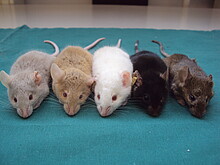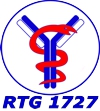Obligatory rules for use of mouse strains within the GRK
The use of animals for experiments is strictly regulated. Hence the following rules have to be strictly applied.
Obtaining govermental approval of the experimental protocol. This protocol has to be submitted to the animal welfare representative of the University, who comments and forwards the protocol to the respective govermental administration. There the proposals are reviewed by scientists and representatives from animal welfare organisations. This comission gives a recommendation on the protcol, and based on this recommendation, the govermental administration takes the decision.
If you have obtained the respective approval of your protocol, the commercially available mice can be shared only within the GRK. Distribution of these mice outside of the GRK is strickly forbidden by regulations from the suppliers.
Mouse strains that are provided by scientists outside the GRK to individual researchers can only be used if a material transfer agreement (MTA) with the providing institution has been made. The MTA limits the use of these mice to agreed projects, to ensure that the intellectual rights of the person who generated the mouse line are protected.
Mouse strains generated within the GRK, can be used by all GRK researchers.
Lines currently generated
Most knockout mouse lines are produced in a C57Bl/6J background. However, to be possible to work with the mouse models of specific diseases, it is necessary to backcross the available knockouts to the respective susceptible mouse recipient; e.g. the H2s haplotype for EBA induction. Therefore, we are currently generating several strains, by successive backcrossing (followed by intercross, to create a homozygous mutant) into the susceptible EBA background.
Below is a list of the actual lines under development:
Trem1-B6J: This line has a homozygous mutation in the Trem1 gene and was exclusively produced in for our lab. Originally, this line was produced in a mixed background and is at the present been backcrossed into the C57Bl/6J background. For this line, we aim to replace the full genome from the mixed to a C57Bl/6J background. To do so, we have to backcross in each generation the heterozygous mice with a C57Bl/6J C57Bl/6J mouse, for at least 10 generations. After the 10th backcross, we will intercross the heterozygous mice, in order to produce a homozygous mutation. As to produce these mice it is necessary a large number of backcross generations, we expect to have this line available in around one year (end of 2016).
GM-CSF-B6J: This line has a homozygous mutation in the GM-CSF gene and was produced in a mixed background by Dranoff et al (1994).
The line is at the present been backcrossed into the C57Bl/6J background. We expect to have this line available in end of this year (end of 2017).
Humanized mice models for Col17 Mice carrying a homozygous deletion for Collagen VII (COL17m- /-) die within 2 weeks of birth due to severe blisters and erosions at sites of trauma. These mice have genital erosions, hemorrhagic blisters around the digits, diffuse, non-pigmented hair growth associated with hair loss, and showed growth retardation compared with wild-type littermates. Mice were rescued by mating them with mice expressing human COL17 under the control of a human keratin 14 promoter (COL17h+). The rescued mice were able to reproduce, in spite of the fact that the original COL17m- /- mice were unable to multiply. To understand the pathogenesis of the diseases and to develop new therapies, animal models corresponding to human autoimmune diseases are essential. Therefore we plan to cross these mice with mice humanized for different Fc-Receptors:
1. mFcer1g-/-, hFcgRIIA (knockout for mouse Fcγ-chain, transgene for human Neutrophil Fcγ Receptors IIA) Tsuboi et al. (2008)
2. mFcer1g-/-, hFcgRIIIB (knockout for mouse Fcγ-chain, transgene for human Neutrophil Fcγ Receptors IIIB) Tsuboi et al. (2008)
3. Fcer1atm1Knt (knockout for mouse Fcε RI alpha-chain, transgene for the human Fc fragment of IgE) http://jaxmice.jax.org/strain/010506.html
4. hFcaRI (transgene for the human Fcα Receptor I) Egmond et al (1999)
The resulting humanized lines have important properties of the human IgG-Fc Receptor interactions and therefore allow testing of human patient IgG in these mice.

- Model systems
Conventional inbred strains
- B10.D1-H2q/SgJ (B10Q)*
- B6.SJL-H2s C3c/1CyJ (B6.s)
- BALB/cJ
- C57BL/6J (B6)
- DBA/1J
- MRL/MpJ
- SJL/J
* Our B10Q colony does not carry the Tyk2 naturally occurring mutation
Unique mouse lines
- B10.D2-Hc0(C5 KO on C57BL/10Sn background)
- B10.D2-Hc1(C5 suficient on C57BL/10Snbackground)
- B6-Ccr2
- B6-CD44
- B6.c-mpl
- B6-C3
- B6-C5ar backcrossed to the B6 background by Prof. Köhl
- B6-C5L2
- B6-Fcer1g
- B6-Fcgr2b
- B6-Foxn1 (B6 nude)
- B6.Gm-csf
- B6-IL10 reporter
- B6-Il1alpha/beta
- B6-Il1beta
- B6-Ucp2
- BALB/c nude
- BcN/LmoJ
- DEREG (on B6 background)
- Lys-EGFP-ki
- B6.s-Fcer1g
- B6.s-Fcgr2b
- B6.s-C5aR1
- B6-Syk
- B6-Cd19 cre
- B6-Lyz cre
- B6-H2k
- B6-CD2 cre
- B6-Vav cre
- B6-BLT1
- B6-Alox5
- B6-Alox15
- BALB/c-GATA1
- B6-CD45.1
- B6-Trem1
- B6-FLP deleter
- BALB/c-CD1
- B6.LyzCre-Sky
- B6.CD2Cre-Sky
- B6.VavCre-Sky
- B6.CD19Cre-Syk
Conplastic Strains
- C57BL/6J-mt129P3/J
- C57BL/6J-mt129S1/SVImJ
- C57BL/6J-mtAKR/J
- C57BL/6J-mtALR/LtJ
- C57BL/6J-mtBPL/1J
- C57BL/6J-mtBUB/BnJ
- C57BL/6J-mtC3H/HeJ
- C57BL/6J-mtCAST/EiJ
- C57BL/6J-mtFVB/NJ
- C57BL/6J-mtKK/HlJ
- C57BL/6J-mtMA/MyJ
- C57BL/6J-mtMRL/MpJ
- C57BL/6J-mtMOLF/EiJ
- C57BL/6J-mtNOD/ShiLtJ
- C57BL/6J-mtNZB/BlNJ
- C57BL/6J-mtPWD/PhJ
- DBA/1J-mtAKR/J
- DBA/1J-mtFVB/NJ
- DBA/1J-mtNOD/ShiLtJ
- MRL/MpJ-mtC57BL/10SnJ
- MRL/MpJ-mtFVB/NJ
- NOD/ShiLtJ-mtFVB/NJ




